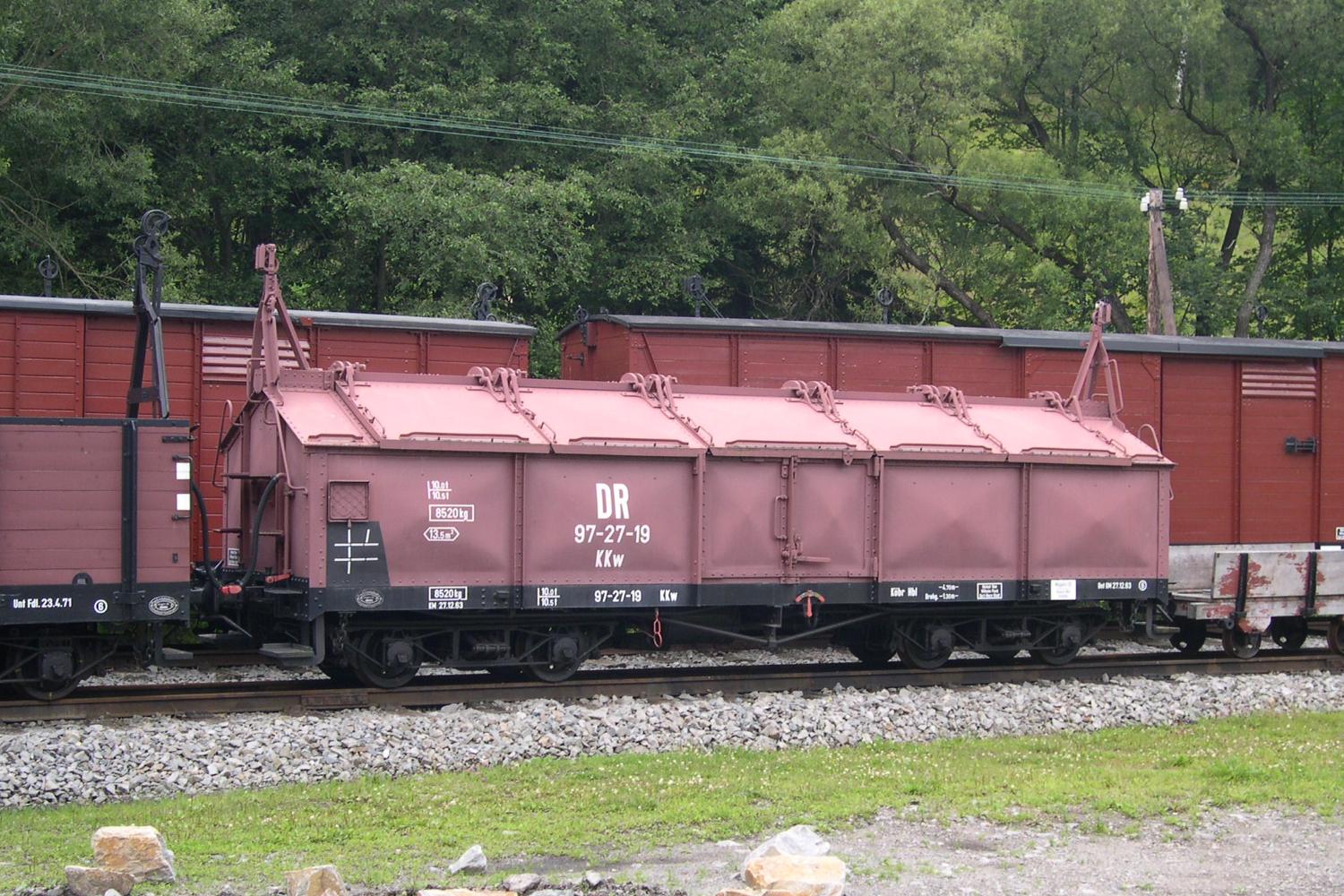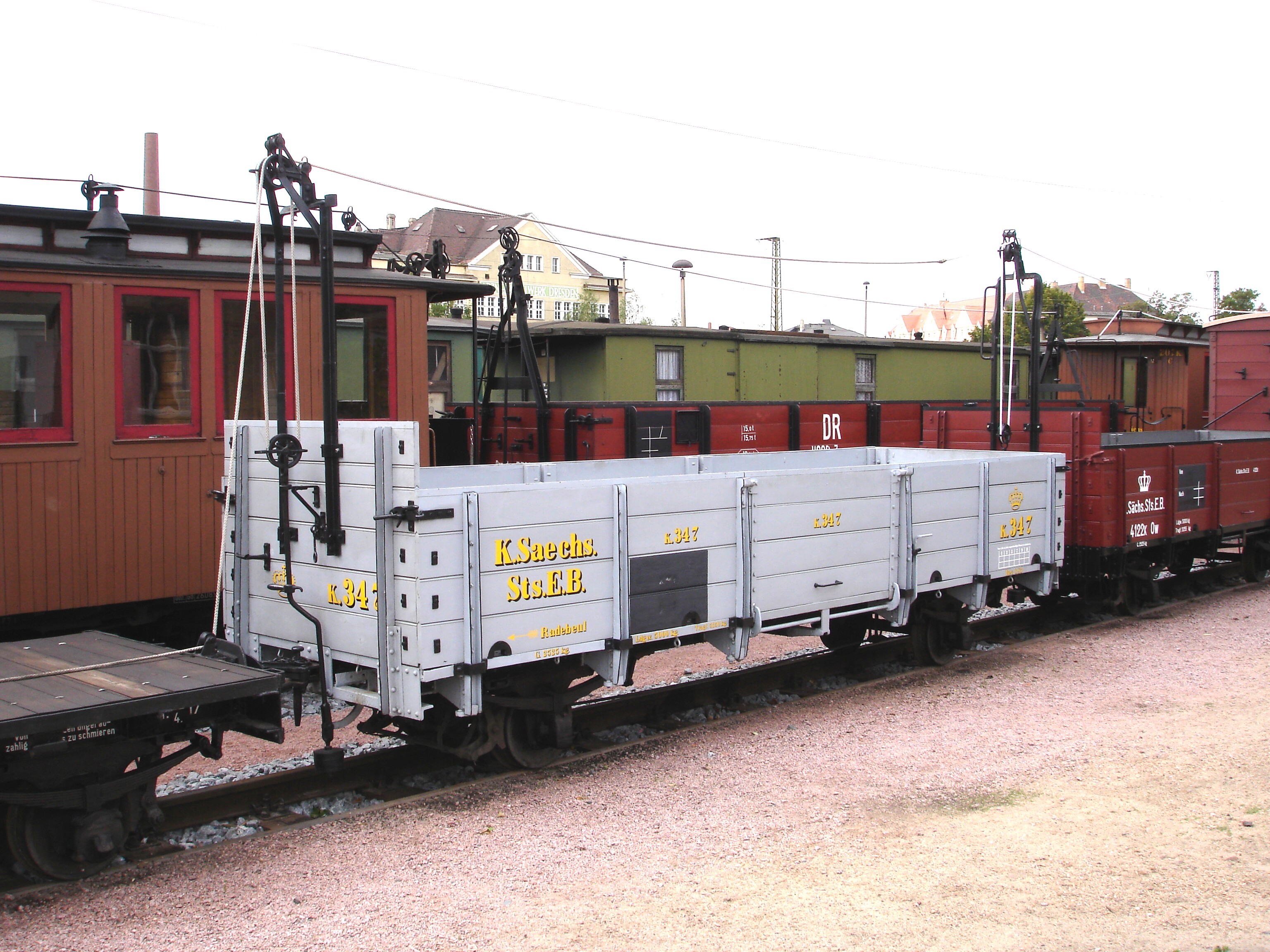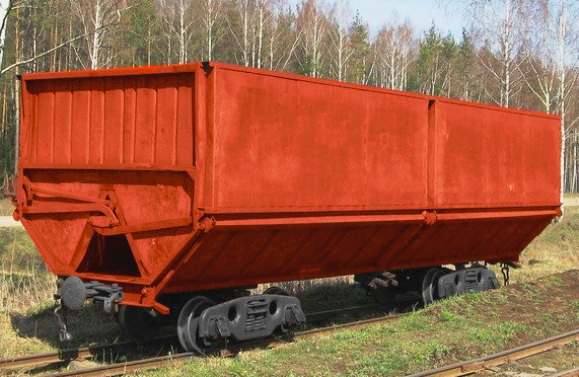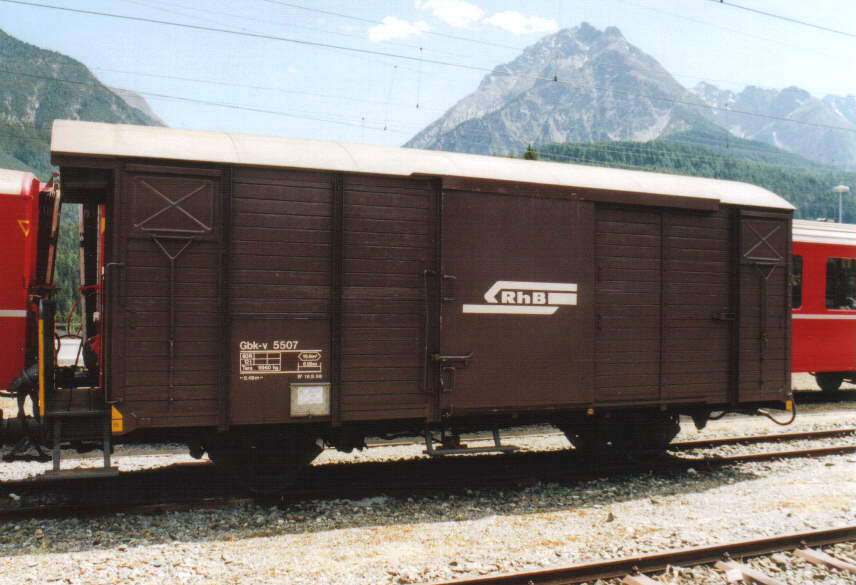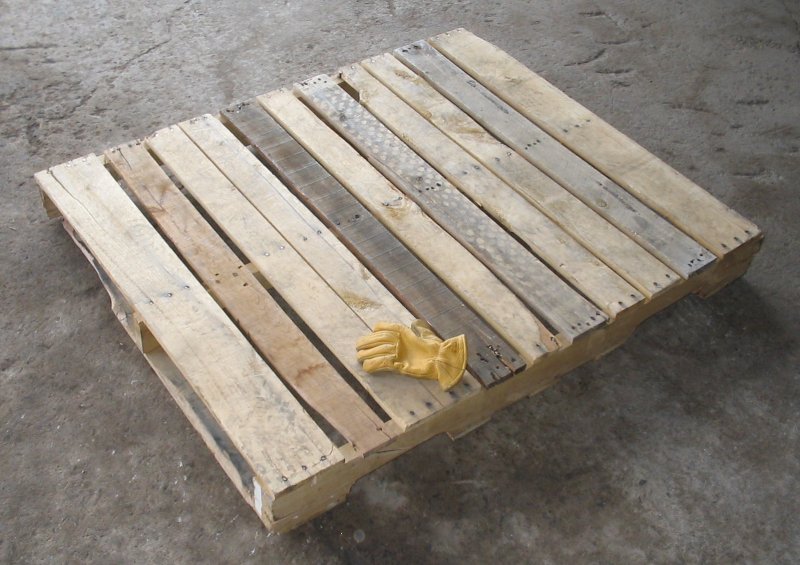|
Wagon With Opening Roof
The wagon with opening roof is a type of railway goods wagon that is, nowadays, defined and standardised by the International Union of Railways (UIC) as Class "T". They are a large category of rail vehicle, predominantly used for the transport of hygroscopic bulk commodities such as cement, plaster, lime, potash and grain. To date, there are four different types of wagon with an opening roof (by way of example, the years refer to when they entered service with the German carrier, DB): * The lidded wagon with several "roof" hatches or lids that can be opened upwards is the oldest type and is rarely seen today. Its disadvantage was that the bars to which the lids were attached meant they could only be opened individually. * In 1951 the sliding-roof wagon was built, whereby half the loading area could be opened up and loaded from above without obstruction at one time. This was achieved by sliding one half of the two-part roof over the other. * In 1958 came the swing-roof wagon which ... [...More Info...] [...Related Items...] OR: [Wikipedia] [Google] [Baidu] |
Goods Wagon
Goods wagons or freight wagons (North America: freight cars), also known as goods carriages, goods trucks, freight carriages or freight trucks, are unpowered railway vehicles that are used for the transportation of cargo. A variety of wagon types are in use to handle different types of goods, but all goods wagons in a regional network typically have standardized couplers and other fittings, such as hoses for air brakes, allowing different wagon types to be assembled into trains. For tracking and identification purposes, goods wagons are generally assigned a unique identifier, typically a UIC wagon number, or in North America, a company reporting mark plus a company specific serial number. Development At the beginning of the railway era, the vast majority of goods wagons were four- wheeled (two wheelset) vehicles of simple construction. These were almost exclusively small covered wagons, open wagons with side-boards, and flat wagons with or without stakes. Over the course of ... [...More Info...] [...Related Items...] OR: [Wikipedia] [Google] [Baidu] |
Open Wagon
Open wagons (trucks in the UK) form a large group of railway goods wagons designed primarily for the transportation of bulk goods that are not moisture-retentive and can usually be tipped, dumped or shovelled. The International Union of Railways (UIC) distinguishes between ordinary wagons (Class E/ UIC-type 5) and special wagons (F/6). Open wagons often form a significant part of a railway company's goods wagon fleet; for example, forming just under 40% of the Deutsche Bahn's total goods wagon stock in Germany. UIC standard goods wagons Since the 1960s, the majority of goods wagons procured by European railway administrations have been built to standards laid down by, or based on, those established by the UIC. In addition to open wagons the table also shows wagons with opening roofs (Class T), whose design is based on open wagons. File:El-Wagen-UIC-Bauart1-Zittau.jpg, Twin-axled UIC Type 1 open wagon, used as an ash wagon, on a transporter wagon in Zittau File:Es-Wa ... [...More Info...] [...Related Items...] OR: [Wikipedia] [Google] [Baidu] |
Buffer (rail Transport)
A buffer is a part of the buffers-and-chain coupling system used on the railway systems of many countries, among them most of those in Europe, for attaching railway vehicles to one another. Description Fitted at the ends of the vehicle frames on the buffer beam, one at each corner, the buffers are projecting, shock-absorbing pads which, when vehicles are coupled, are brought into contact with those on the next vehicle. The buffer itself comprises the buffer plates which take the impact. The draw chain used between each pair of vehicles includes a screw which is tightened after coupling to shorten the chain and keep the buffers pressed together. Such is known as a 'screw coupling'. Historically, coupling chains were no more than that, a short length of heavy chain (typically three links long) with no adjustment. These would result in a 'loose-coupled train' in which the buffers of adjacent vehicles would only touch when the coupling chain was fully slack, such as when being pus ... [...More Info...] [...Related Items...] OR: [Wikipedia] [Google] [Baidu] |
UIC Class
This list contains the UIC classification of goods wagons and their meanings. The description is made up of a category letter (in capitals) and usually several index letters (in lower case). The international system for the classification of goods wagons was agreed by the ''Union internationale des chemins de fer'' (UIC) in 1965 and subsequently introduced into member countries. For example it was adopted in Germany on 1 January 1968 replacing the previous German railway wagon classes that originated as early as 1905. The UIC classification has been amended several times since it began. Not all wagons are given UIC designations. In Germany the few remaining guards vans and narrow gauge goods wagons have retained their original classifications. Category letters The following table contains the complete list of standard category letters. Letters A, B, C, D, P and W are reserved for coaches. However, also S is used for coaches and this doubles a goods wagons class.COMMISSION DECISI ... [...More Info...] [...Related Items...] OR: [Wikipedia] [Google] [Baidu] |
Open Wagon
Open wagons (trucks in the UK) form a large group of railway goods wagons designed primarily for the transportation of bulk goods that are not moisture-retentive and can usually be tipped, dumped or shovelled. The International Union of Railways (UIC) distinguishes between ordinary wagons (Class E/ UIC-type 5) and special wagons (F/6). Open wagons often form a significant part of a railway company's goods wagon fleet; for example, forming just under 40% of the Deutsche Bahn's total goods wagon stock in Germany. UIC standard goods wagons Since the 1960s, the majority of goods wagons procured by European railway administrations have been built to standards laid down by, or based on, those established by the UIC. In addition to open wagons the table also shows wagons with opening roofs (Class T), whose design is based on open wagons. File:El-Wagen-UIC-Bauart1-Zittau.jpg, Twin-axled UIC Type 1 open wagon, used as an ash wagon, on a transporter wagon in Zittau File:Es-Wa ... [...More Info...] [...Related Items...] OR: [Wikipedia] [Google] [Baidu] |
Covered Goods Wagon
A covered goods wagon or van is a railway goods wagon which is designed for the transportation of moisture-susceptible goods and therefore fully enclosed by sides and a fixed roof. They are often referred to simply as covered wagons, and this is the term used by the International Union of Railways (UIC). Since the introduction of the international classification for goods wagons by the UIC in the 1960s a distinction has been drawn between ordinary and special covered wagons. Other types of wagon, such as refrigerated vans and goods wagons with opening roofs, are closely related to covered wagons from a design point of view. Similar freight cars in North America are called boxcars. Covered goods wagons for transporting part-load or parcel goods are almost as old as the railway itself. Because part-load goods were the most common freight in the early days of the railway, the covered van was then the most important type of goods wagon and, for example, comprised about 40% of th ... [...More Info...] [...Related Items...] OR: [Wikipedia] [Google] [Baidu] |
Swinging Roof Wagons And Roller Roof Wagons With Level Floors
Swing or swinging may refer to: Apparatus * Swing (seat), a hanging seat that swings back and forth * Pendulum, an object that swings * Russian swing, a swing-like circus apparatus * Sex swing, a type of harness for sexual intercourse * Swing ride, an amusement park ride consisting of suspended seats that rotate like a merry-go-round Arts, entertainment, and media Films * ''Swing'' (1938 film), an American film directed by Oscar Micheaux * ''Swing'' (1999 film), an American film by Nick Mead * ''Swing'' (2002 film), a French film by Tony Gatlif * ''Swing'' (2003 film), an American film by Martin Guigui * ''Swing'' (2010 film), a Hindi short film * ''Swing'' (2021 film), an American film by Michael Mailer Music Styles * Swing (jazz performance style), the sense of propulsive rhythmic "feel" or "groove" in jazz * Swing music, a style of jazz popular during the 1930s–1950s Groups and labels * Swing (Canadian band), a Canadian néo-trad band * Swing (Hong Kong band), a Hong ... [...More Info...] [...Related Items...] OR: [Wikipedia] [Google] [Baidu] |
Forklift Truck
A forklift (also called lift truck, jitney, hi-lo, fork truck, fork hoist, and forklift truck) is a powered industrial truck used to lift and move materials over short distances. The forklift was developed in the early 20th century by various companies, including Clark, which made transmissions, and Yale & Towne Manufacturing, which made hoists. Since World War II, the use and development of the forklift truck have greatly expanded worldwide. Forklifts have become an indispensable piece of equipment in manufacturing and warehousing. In 2013, the top 20 manufacturers worldwide posted sales of $30.4 billion, with 944,405 machines sold. History The middle nineteenth century through the early 20th century saw the developments that led to today's modern forklifts. The forerunners of the modern forklift were manually-powered hoists that were used to lift loads. In 1906, the Pennsylvania Railroad introduced battery-powered platform trucks for moving luggage at their Altoona, Penn ... [...More Info...] [...Related Items...] OR: [Wikipedia] [Google] [Baidu] |
Pallet
A pallet (also called a skid) is a flat transport structure, which supports goods in a stable fashion while being lifted by a forklift, a pallet jack, a front loader, a jacking device, or an erect crane. A pallet is the structural foundation of a unit load, which allows handling and storage efficiencies. Goods in shipping containers are often placed on a pallet secured with strapping, stretch wrap or shrink wrap and shipped. Since its invention in the twentieth century, its use has dramatically supplanted older forms of crating like the wooden box and the wooden barrel, as it works well with modern packaging like corrugated boxes and intermodal containers commonly used for bulk shipping. In addition, pallet collars can be used to support and protect items shipped and stored on pallets. While most pallets are wooden, pallets can also be made of plastic, metal, paper, and recycled materials. Overview Containerization for transport has spurred the use of pallets because sh ... [...More Info...] [...Related Items...] OR: [Wikipedia] [Google] [Baidu] |
Railway Museum
A railway museum is a museum that explores the history of all aspects of rail related transportation, including: locomotives ( steam, diesel, and electric), railway cars, trams, and railway signalling equipment. They may also operate historic equipment on museum grounds. Africa Egypt *Egypt's Railway Museum (Cairo) Kenya * Nairobi Railway Museum in Nairobi Nigeria * NRC/Legacy Railway Museum in Lagos Sierra Leone *Sierra Leone National Railway Museum in Freetown South Africa *Outeniqua Transport Museum in George Sudan * Railway Museum in Atbarah Zambia *Railway Museum in Livingstone Zimbabwe * Bulawayo Railway Museum in Bulawayo Asia China *Chan T'ien-yu Memorial Hall, Badaling, Beijing * China Railway Museum, Beijing * Da'anbei Railway Station, Da'an, Jilin Province *Hong Kong Railway Museum * Qingdao-Jinan Railway Museum, Jinan, Shandong Province *Shanghai Railway Museum, Shanghai *Shenyang Railway Museum, Shenyang, Liaoning Province *Wuhan Metro Museum, ... [...More Info...] [...Related Items...] OR: [Wikipedia] [Google] [Baidu] |
